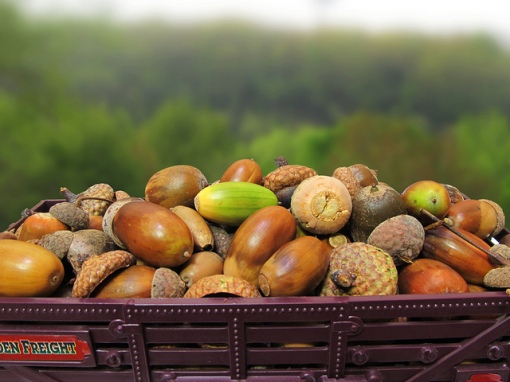
Acorns are very common in Southern Canada, but how much do you know about them? Photo by moonimage, acorns, CC, https://www.flickr.com/photos/moonimage/9166449223/
“Are acorns nuts?” my roommate asked out of the blue.
The science nerd in me struggled to remember the botanical definition of a nut.
Being a normal human being, my roommate was interested in more practical matters; “If kids are bringing them into a nut-free daycare, will kids with nut allergies react to them?”
Good question. I had no idea. But Google did.
The short answer is no, allergies to acorns are quite rare. There has never been a recorded death related to an acorn allergy. Therefore, kids with tree-nut allergies who pick up and play with acorns will be fine.
However, acorns are still a tree nut, so just in case kids shouldn’t be eating them! Thankfully acorns are very bitter, and not likely to be ingested. We’ll get to that later.
Being an inquisitive botany geek, I naturally wanted to learn more about acorns. Let’s learn together, shall we?
1. Acorns are nuts, but almonds aren’t!
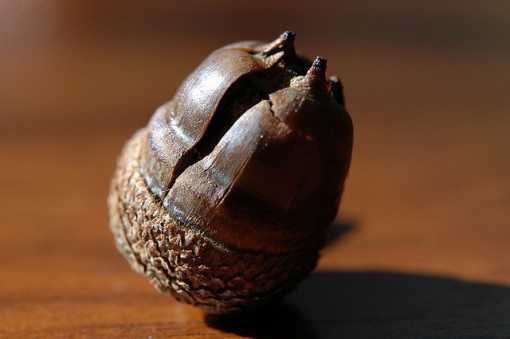
The hard case of this acorn is split open, revealing the yummy fruit inside! Photo by John, cygnus921, Acorn 020, CC, https://www.flickr.com/photos/cygnus921/2955260269/
It turns out that botanically a nut is a very special beast. A nut is a hard, dry pod that surrounds the fruit and a single seed inside. Think chestnuts, hazelnuts and acorns! Almonds are actually drupes, like plums and peaches.
2. Meet the family
There are 450 species of oak trees wordwide, but only 13 in Canada. Most of our native species hang out in the most southern parts of the country. The Cork Oak (Quercus suber) is where all your wine corks come from, and the waterproof wood of the White Oak is used for wine barrels.
3. Geeky Canadian trivia
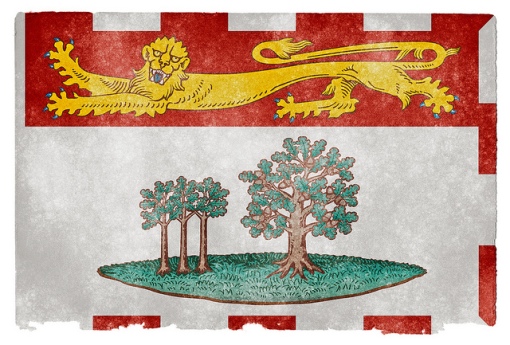
Quick, which province does this flag represent? Photo by Nicolas Raymond, Prince Edward Island Grunge Flag, CC, https://www.flickr.com/photos/80497449@N04/7384695152/
Quick, which Canadian province has acorns on its flag? If you guessed Prince Edward Island, you’re right! There are four oak trees on the flag, one represents England and three others represent the three counties of Prince Edward Island. The Red Oak, a native tree prized for its wood ideal for furniture making, is also the province’s official tree. Who knew?
4. Sexy acorns
Can you guess which part of the male anatomy was named after the acorn? It’s the glans, or head of the penis! Glans the Latin word for acorn. I guess the 17th century English thought there was some resemblance. No, I’m not going to draw you a picture.
5. Essential fall food!
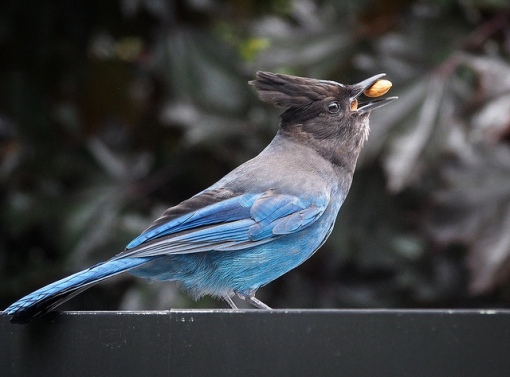
Birds and beasts of all kinds love snacking on acorns. Photo by Ingrid Taylar, A Caching Steller’s, CC, https://www.flickr.com/photos/taylar/7331902826/
We often see squirrels with acorns, but did you know that deer eat them too? 25% of a deer’s fall diet is acorns! Mice, woodpeckers, blue jays and ducks like to snack on them too. Oak trees depend on animals to carry their acorns somewhere else, bury them, and then forget about them so a new tree can start growing.
6. Essential human food!
Acorns have been eaten by many different cultures for thousands of years. In North America, some groups of Aboriginal peoples depended on acorns. For example, it is estimated that 75% of the Aboriginal people in California relied on acorns on a daily basis. Most oak trees only produce acorns every 2-3 years, so most groups found ways to store unshelled nuts for 10-12 years in granaries. Today the descendants of these groups use acorns as special traditional foods, but do not eat them every day.
7. Nutritional powerhouses
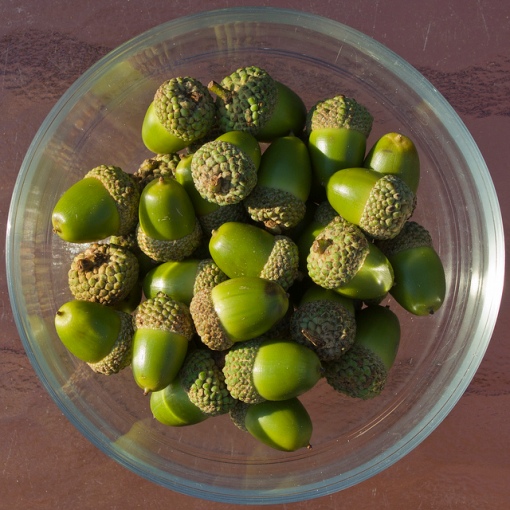
Acorns are packed with nutrients! Though not these ones, because they aren’t ripe yet. Photo by woodleywonderworks, Fruit From Hurricane Irene (green acorns), CC, https://www.flickr.com/photos/wwworks/6094598165/
There’s a reason so many people have eaten acorns throughout history- they are abundant and really good for you. Some acorns are 18% fat, 6% protein and 68% carbohydrate, equivalent to modern corn and wheat. They are also great sources of vitamin A and C.
8. Tricky tannins
There is only one problem about eating acorns-they mess with your insides! Well, not dangerously so, but they contain tannin, a bitter chemical that we humans use to tan leather. Too much tannin in your sensitive intestines makes it hard for them to get any nutrients out of the food you’re eating! So acorns may be super good for you, but if you’re eating them raw your body will never see any of those wonderful nutrients. You’ll also be left with a bitter taste in your mouth. Tannins are also found in berries and pomegranates, but acorns take tannins to the next level.
Well, that’s not very nice of oak trees, is it? It’s actually a clever defense mechanism. If all their acorns get eaten, none will turn into baby trees. So the bitter tannins are a way to discourage animals from eating their seeds. Pretty neat, huh?
Unfortunately for the oak trees, many animals have found ways to get around tannins. Some animals have special digestive systems that destroy the tannins before they can do their thing. Other animals like squirrels, deer and pigs eat so many acorns at once that it doesn’t matter that they aren’t absorbing all possible nutrients. Humans have a different adaptation-soaking the nuts in water to rinse out the tannins.
As we head into fall, hopefully you’ll look at all those fallen acorns in a different light!
References
http://www.csus.edu/anth/museum/pdfs/Past%20and%20Present%20Acorn%20Use%20in%20Native%20California.pdf
http://www.hastingsreserve.org/OakStory/Acorns2.html
http://books.google.ca/books?id=tnwAlLgWEhAC&pg=PA114&lpg=PA114&dq=penis+glans+named+after+acorn&source=bl&ots=kMGAkN3DzA&sig=Od-y1vkXd2y2KIQl-3wuCsVajSg&hl=en&sa=X&ei=5t4AVMilCs6_sQSm_4HoCA&ved=0CCMQ6AEwAQ#v=onepage&q=penis%20glans%20named%20after%20acorn&f=false
http://ontariosown.ca/uncategorized/nuts-about-acorns/
http://www.gov.pe.ca/infopei/index.php3?number=1599
http://www.gardenguides.com/101927-oak-trees-canada.html
http://www.ontario.ca/environment-and-energy/white-oak
http://ontariosown.ca/uncategorized/nuts-about-acorns/
http://www.britannica.com/EBchecked/topic/422776/nut
http://www.seriouseats.com/2010/04/what-are-the-differences-between-nuts-and-drupes.html
http://www.biology-online.org/dictionary/Nut
http://www.britannica.com/EBchecked/topic/423415/oak
http://www.schoolhealthservicesny.com/uploads/Acorns%20Pinecones.pdf
http://www.anaphylaxis.org.uk/what-is-anaphylaxis/knowledgebase/tree-nut-allergy–acorns?page=11
http://blog.onespotallergy.com/2012/11/newstalk1010-interview-are-acorns-a-risk-if-youre-allergic-to-tree-nuts/


Pingback: Best 23 Is An Acorn A Fruit - Sky Park Residence
Pingback: Best 16 Is A Acorn A Fruit - Sky Park Residence
Sorry, I don’t know. Have fun finding out!
How much price of one kg ocorns?
Huh. This was an interesting and funny article, that I found due to a similar debate with my 9 year old. Thanks! Until today, I never knew all the crazy acorn uses and facts – found from other sources also! ….used to have the kids compete to find the most acorns as a way to keep them busy (without electronics or while camping) – maybe I shouldn’t have thrown them all out!? Its probably best that I did though 🙂
Thanks Dave, I appreciate the kind words. I wish your daughter best of luck on her acorn research and future scientific endeavors.
Very informative learned stuff I didn’t know before me and my daughter whose a future scientist was doing research about acorns which you provided nicely, very cool and interesting thank you keep up the good work.
Pingback: 8 choses que vous ne saviez pas sur les glands | lab bench to park bench
I’m very sorry to hear about your dog, Shirley. I’m not a veterinarian, so I don’t know if consuming acorns contributed to your dog’s kidney problems. I would certainly bring it up with a vet if you are worried about the effects of acorns on future pets. Again, my condolences.
We just put our dog down due to kidney problems. I believe it was due to eating acorns for a lot of years. Do you think that’s possible?
Thank you Tony. I didn’t know squirrels would go for the saplings too. I hope your oak trees will be able to bounce back.
This is a very interesting post. There are some oak trees south of where I live, in Toronto, and magnificent ones outside the Royal Ontario Museum, but it’s difficult for young ones to establish themselves as squirrels not only love the acorns, but gnaw on the saplings. The ones near me were damaged in last winter’s ice storm, and I’d hate to see them go.